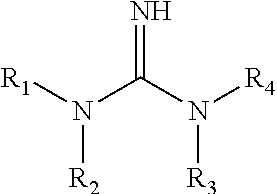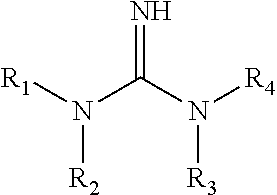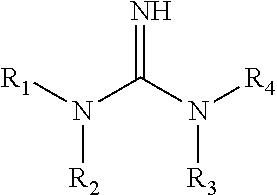Reduced Emissions Low Density Spray Polyurethane Foam
- Summary
- Abstract
- Description
- Claims
- Application Information
AI Technical Summary
Benefits of technology
Problems solved by technology
Method used
Image
Examples
example 1
Rate of Rise of Foam Prepared with Standard Emissive Amine Catalyst Blend (BDMAEE and DMAEE)
[0053]The following formulation was used to make foam using the industry standard catalysts combination bis-(dimethylaminoethyl)-ether (BDMAEE) and dimethylaminoethoxy ethanol (DMAEE).
ComponentsPartsPolyether Polyol30.94Emulsifier (Nonylphenol ethoxylated) 9.88Flame Retardant (TCPP) (Tris(2-23.74trichloroisopropyl)phosphateSurfactant (Silicon surfactant)1.05Cell Opener (Polybutadiene and / or0.05polyoctenylene cell opener)Standard 1: DABCO ®BL-115.28Bis(dimethylaminoethyl)etherCo-catalyst: DMAEE2.24(Dimethylaminoethoxyethanol)Water18.05MDI91.23
[0054]The above components were mixed and allowed cooling to about 5° C. before mixing with the corresponding amount of isocyanates. Approximately 25 g of the above premix were mixed with 25 g of isocyanate (MDI) in a mechanical agitator in a two litter plastic container. Start time, rate of rise, foam height, speed of foam formation were measured using a...
example 2
Foam Rate of Rise of Comparison Betwen BMDAEE / DMAEE Control and TMG (Tetramethylguanidine [TMG])
[0055]Foams were prepared in a similar manner as the previous example. Tetramethylguanidine was used at two different use levels as shown in the table below.
Components#2#3Polyether Polyol30.9430.94Emulsifier (same as above)9.889.88Flame Retardant (TCPP) (same as above23.7423.74Surfactant (same as above)1.051.05Cell Opener (same as above)0.050.05TMG (Tetramethylguanidine)2.508.00Water18.0518.05MDI91.2391.23
[0056]Data below shows that the kinetic of rate of rise for foam #2 is much lower than the control standard. Increasing the level of TMG as in foam #3 gave a much faster kinetic than #2 and more comparable to the industry standard. However, increasing the level of TMG had a deep negative impact on foam height. Furthermore, the physical properties of foam made with TMG are very poor and foam degradation was immediately seen after foam curing. The complete lack of mechanical integrity of f...
example 3
Foam Rate of Rise Comparison Betwen BMDAEE / DMAEE Control and Non-Emissive Catalyst Combination “A” Polycat®-15 / Dabco®-T
[0057]This example shows a comparison between the standard catalyst composed of a mixture of BDMAEE / DMAEE and catalyst combination “A” of non-emissive catalysts that includes 85% bis(dimethylaminopropyl)amine (commercially available as Polycat®-15) and 15% N-(dimethylaminoethyl)-N-(2-hydroxyethyl)-N-methylamine (commercially available as Dabco®). It is clear from the graph below that the standard is significantly more active that the non-emissive catalyst combination. While the BDMAEE / DMAEE standard is used at 7.52 parts the non-emissive catalyst combination requires a much higher use level and even at 8.5 parts some small front end delay is still observed as evidenced by choice time and rise time. The low catalytic activity is due to a combination of factors including catalyst immobilization and ineffective water activation as compared with BDMAEE.
ParameterControl“...
PUM
| Property | Measurement | Unit |
|---|---|---|
| Fraction | aaaaa | aaaaa |
| Fraction | aaaaa | aaaaa |
| Fraction | aaaaa | aaaaa |
Abstract
Description
Claims
Application Information
 Login to View More
Login to View More - R&D
- Intellectual Property
- Life Sciences
- Materials
- Tech Scout
- Unparalleled Data Quality
- Higher Quality Content
- 60% Fewer Hallucinations
Browse by: Latest US Patents, China's latest patents, Technical Efficacy Thesaurus, Application Domain, Technology Topic, Popular Technical Reports.
© 2025 PatSnap. All rights reserved.Legal|Privacy policy|Modern Slavery Act Transparency Statement|Sitemap|About US| Contact US: help@patsnap.com



